Hanged murderer's extra punishment – to be handed over for medical research
Abel Hill, a cold blooded murderer who killed his pregnant wife and their 16-month-old daughter, “made use of the most horrid expressions” when returned to his cell following sentence.

Even Stafford Gaol’s chaplain “failed in his attempts to tranquilise the condemned man’s mind and prepare him for eternity”, a surviving newspaper cutting reveals.
The Bilston double-killer’s despair was understandable. His punishment went beyond the noose and the drop. Awaiting Hill was a fate much worse than death.
At Stafford Assizes on that warm July day in 1820, the judge fixed Hill with a granite-hard stare and solemnly announced: “You, Abel Hill, be taken hence to the place from whence you came and from thence, on Thursday the 27th of July, to a place of execution and that you be hung by the neck till you are dead and that your body, when taken down, dissected and anatomised.
“And may God, in his infinite mercy, have mercy upon your soul.”

In layman’s terms, the 23-year-old pit worker would not only lose his life, but forfeit his dead body to medical research. It would be carved up by surgeons and experimented upon – a dreaded end added to the statute books by the 1752 Murder Act.
That act, in essence, introduced a three-tier capital punishment system: “social”, the court case and verdict; “legal”, the gallows; “medical”, the professional mutilation. “Post mortem punishment” was dreaded and therefore effective. It pandered to the belief dissected bodies were refused entry to heaven.
Criminals were terrified by the possibility. Hill’s ashen face was creased with abject fear and he pitched forward as sentence was passed.
The punishment was based on morbid rationale. Medical science needed fresh cadavers and that need had sparked a body-snatching black market. Thieves even pilfered corpses hanging on public display in gibbets.
It had no age barrier. Sarah Huntingford, executed for the murder of her husband in 1818, was 61. John Amy Bird Bell was only 14 when found guilty of killing a 13-year-old in 1831.
It was popular among the masses who not only gathered in their hundreds to witness public executions, but then queued patiently for tickets to the dissection.





